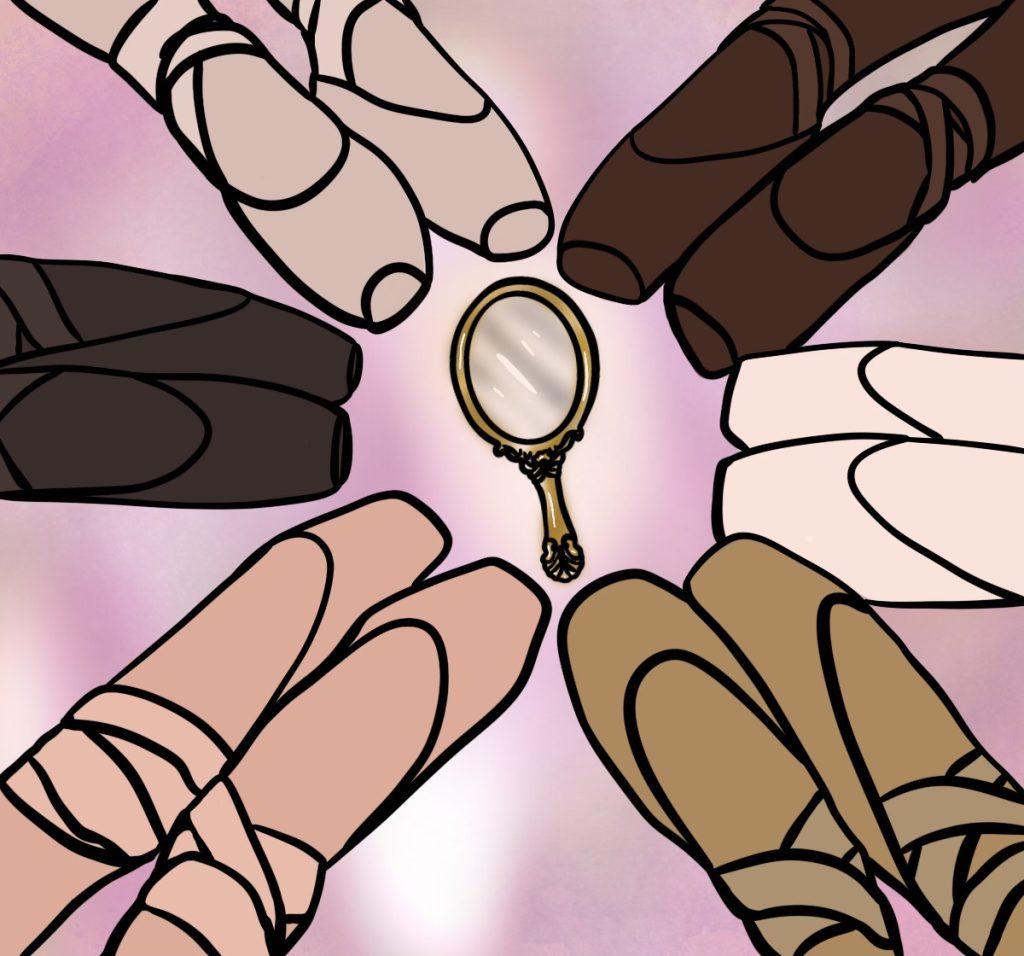Art by Sarah Rietz
Transparency Item: The Perspectives section of the Graphic is comprised of articles based on opinion. This is the opinion and perspective of the writer.
Ballet is often seen as a universal language of expression, transcending borders and cultures. It is a form of art that reflects the diversity of the human experience.
So, why then have we clung so stubbornly to the archaic notion that a pale, pink pointe shoe is the only acceptable choice for dancers? It’s time for the ballet world to eliminate these outdated norms and truly embrace the spirit of diversity and of human decency.
Pointe shoes should no longer be confined to a single shade of European pink. Instead, they should embrace all the skin tones that make up our world.
I grew up in center-city Philadelphia, where I attended a ballet studio for the majority of my upbringing. In class, I was one of four other “pale,” white ballerinas. The rest of the dancers were Black or had darker skin tones — yet we were the only ones who could look in the studio mirror and see our shoes matched the rest of our bodies.
It was this unspoken thing that everyone brushed under the rug and ignored. I don’t know why it was never talked about considering how blatantly obvious it was for years.
One of the ballerinas I have admired since childhood, Misty Copeland, has long advocated for companies making pointe shoes in different shades.
Each time I hear her speak on this topic or watch her “Day in a Life” videos on YouTube, it instantly places me back in the ballet studio, where day after day, I would tie my European pink pointe shoes and realize that the majority of my friends’ shoes didn’t match them and how awful and excluding that must have felt.
The argument in favor of expanding the color palette of pointe shoes is not just about looks; it’s a statement about inclusion and representation. For far too long, dancers of color have had to contort themselves to fit into a mold that was never designed with them in mind.
They’ve had to dye their shoes — “pancake” them — or endure the discomfort of shoes that don’t match their skin tone. This is not only impractical but also sends a message that they are somehow less deserving of being seen as the embodiment of a true ballerina.
Imagine a ballet stage where dancers can confidently perform without the burden of mismatched shoes. Imagine a young dancer of any skin tone looking at their reflection in the studio mirror and seeing themselves represented in every aspect of their art, right down to the very shoes they wear.
Ballet is about elegance, beauty and strength, and how can anyone perform to the best of their abilities without the proper attire needed to complete this goal?
It’s important to note that this is not an attack on tradition but rather an evolution of it. Ballet is a living art form, and like all art forms, it must adapt and grow with the times. Just as ballet itself has evolved from its rigid origins to a more expressive and inclusive art form, so too should its attire.
Critics might argue that expanding the color range of pointe shoes would be costly or logistically challenging. However, the same arguments were made when dance companies started casting dancers of different ethnic backgrounds in roles traditionally reserved for white performers, according to JSTOR. The same forward thinking should apply to pointe shoes.
The cost of paint or the challenge of finding suitable materials are small prices to pay for the monumental ways that they promote equity and inclusivity. Freed of London and BalletBlack have already taken jumps in the right direction, and more companies should follow suit.
Pointe shoes in all skin-tone shades are a recognition that beauty and grace come in many types and that talent should never be constrained by the color of one’s footwear. It’s a call for ballet to reflect the world it exists in — a world that is beautifully diverse.
It’s time for ballet to take a leap forward and get rid of the restrictive notion of European pink as the standard for pointe shoes.
___________________
Follow the Graphic on Twitter: @PeppGraphic
Contact Victoria La Ferla via email:
Victoria.laferla@pepperdine.edu or by instagram @vlf_insider

